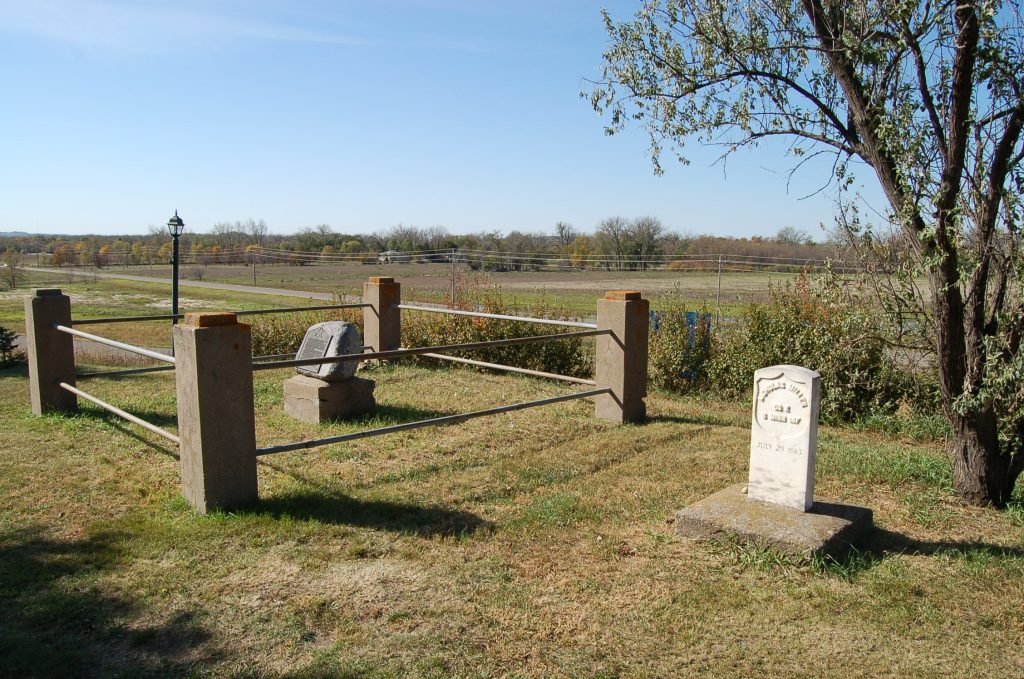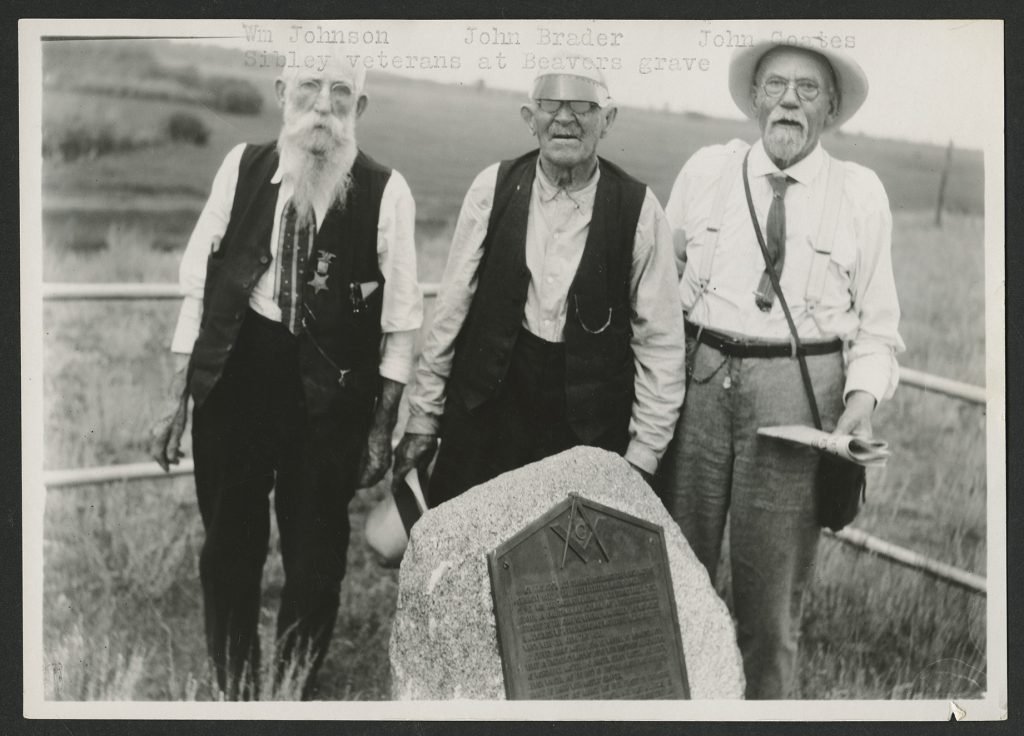
| “Frederick John Holt Beever was a 33-year-old Englishman who was born into privilege. He attended Jesus College at Oxford, but he had a yearning for adventure. He came to the mid-western part of the United States to hunt buffalo, but instead he took a staff position on General Henry Sibley’s 1863 expedition into Dakota Territory. On July 29, 1863, the expedition was at the Missouri River near present-day Bismarck. Colonel William Crooks, the commander of the Sixth Minnesota Regiment, had taken his regiment into the woods bordering the east bank of the river. Beever, who had not accompanied Crooks, wanted to see the river. He talked to Sibley about this and Sibley dispatched him to carry a message to Crooks. Beever delivered this message and was carrying a message back to Sibley. However, he did not make it back to Sibley’s camp. that night concerned colleagues noticed that he was missing. The next day, July 30, a large search party was sent out and found his body. While on the way back to Sibley’s camp, some Dakota shot and killed Beever. He had been armed with two revolvers and was a good shot. He may have wounded some Dakota since there were two pools of blood near his body. He was buried on July 31 in a crude coffin at Camp Slaughter at the mouth of Apple Creek. A Free Masonry ceremony was conducted at the burial. His remains were later moved to Fort Snelling, and then on September 26, 1865, to Oakland Cemetery in St. Paul. The gravestone dates from that time” – Dakota Uprising Victims: Gravestones & Stories, by Curtis A. Dahlin, p. 105. |

| “The Sibley Expedition. A correspondent who writes from ‘Camp in Dacotah, August 15,’ furnishes us with sketches of events in General Sibley’s Expedition against the Sioux. He says, ‘The sketch of the Murder of Lieutenant Beever is a truthful one, so far as could be gathered from the examination of those who visited the scene immediately after.’ He was a wealthy Englishman, who had served through the Crimean campaigns, and finally came to this country in search of adventures. He was about thirty years old. He left behind him in New York a fine yacht in which he had once sailed on a pleasure trip to the West Indies. Being on General Sibley’s staff, he had been sent with a dispatch to Colonel Crooks, who was skirmishing with the Indians. He fell into an ambush and was murdered. One side of his face was hacked off with a hatchet while he was still alive. The illustrations on page 580 represent two incidents in the history of this Expedition. The first shows the Train Crossing the James River on the 20th of July. The locality is about 600 miles west of St. Paul, and 100 east of the Missouri, which was the destination of the Expedition. Up to this time the Indians had kept out of sight. But two days after they were massed to the number of 4000 in front of the Expedition. The James River is nearly as black as ink, and the crossing of it by four hundred wagons occupied nearly four hours. There is but one clear stream in Dacotah Territory, the Cheyenne. The Expedition, on its return a fortnight after, crossed the river at a different point. The other illustration represents The Sioux After the Battle of Big Woods, on the 24th of July. The savages, on being attacked, retreated from hill to hill of the Coteau du Missouri, and were finally pursued into a valley where they had recently been encamped. The entire train of the fugitives at last came in sight, and good work was done upon them by our shell and shot. Had not General Sibley’s forces been exhausted by a long day’s march, by the subsequent fight and pursuit, the whole Sioux force might have been captured. As it was, they succeeded in escaping across the Missouri, which was not fordable by our train. The illustration shows the savages fleeing in confusion between the lakes, with Sibley and his staff upon a hill in the fore-ground.” – Text with article from Harper’s Weekly, Sept. 12, 1863, p. 587.<br>”Lt. Beaver’s Grave Site. On this spot, July 31, 1863, occurred the first Masonic ceremony held in the present state of North Dakota. It was the Masonic funeral of Lieutenant Fred J. Holt Beaver [sic], an Englishman and Oxonian, and a volunteer soldier attached to the staff of General H.H. Sibley. He was killed in a skirmish with the Indians and was buried in the rifle pits which were dug along this ridge. Duputy Grand Master John C. Whipple of Minnesota convened an emergency Masonic Lodge with Brothers A.J. Edgerton as Worshipful Master, J.G. Braden, Senior Warden, and Patch, Junior Warden, and the body of Brother Beaver [sic] was here consigned to earth with Masonic services. This tablet and marker has been placed by the Grand Lodge, A.F. and A.M. of North Dakota, A.D. 1920, A.L. 5920, to commemorate the fact that while Lieutenant Beaver [sic] died far from home and among strangers, yet he was among brethren who saw that the honors so justly his due were paid him.” – Text on plaque, located south of Bismarck, N.D.<br>”Killing of Lt. Beever. While Col. Crooks was at the river the General sent an order by Lieut. Beever, Aid-de Camp. While returning with an answer, Lieut. Beever mistook a trail that led down the river, where his body was found next day pierced by three arrows and a ball. He had also wounds from a tomahawk on his head. His horse lay near him. Two pools of blood twenty paces from his body indicated that two of his murderers had paid dearly for his life. On the same trail was found the body of private Nicholas Miller, of Company K, Sixth Regiment, who had made the same mistake in taking the trail that Beever had” – St. Paul Daily Press, August 15, 1863. |



Lt Beaver Masonic Memorial Bismarck, Burleigh County, North Dakota, USA

Sibley Expedition veterans William Johnson, John Brader, and John Coates stand at the Masonic memorial to Lieutenant Frederick Beaver near Apple Creek in Burleigh County, N.D.||Lieutenant Beaver (or Beever) was killed near the mouth of Apple Creek while Sibley’s troops waited for Sully to arrive from the south. Beaver and Corporal Nicholas Miller had ridden away from camp and were attacked by Dakotas. Beaver was the first Mason to be buried in North Dakota. Masons later honored him with a monument. Years later, veterans of the Sibley Expedition, William Johnson, John Brader, and John Coates visited Beaver’s grave marker.


Oakland Cemetery Saint Paul, Ramsey County, Minnesota, USA
